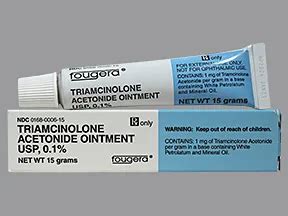Intro
Discover the uses and benefits of Triamcinolone Acetonide Ointment, a topical corticosteroid cream for skin conditions. Learn how it treats eczema, psoriasis, dermatitis, and allergies, reducing inflammation and itching. Explore its advantages, side effects, and application guidelines for optimal results.
Triamcinolone acetonide ointment is a topical corticosteroid medication that has been widely used for decades to treat various skin conditions. Its versatility, effectiveness, and relatively low cost have made it a staple in many dermatologists' and healthcare providers' treatment arsenals. In this article, we will delve into the uses and benefits of triamcinolone acetonide ointment, providing an in-depth look at its applications, mechanisms of action, and potential side effects.
What is Triamcinolone Acetonide Ointment?

Triamcinolone acetonide ointment is a synthetic corticosteroid that belongs to the class of medications known as topical corticosteroids. It is available in various strengths, ranging from 0.025% to 0.5%, and is commonly used to treat skin conditions that involve inflammation, itching, and redness.
Uses of Triamcinolone Acetonide Ointment
Triamcinolone acetonide ointment has a wide range of applications, including:
- Atopic dermatitis (eczema): Triamcinolone acetonide ointment is often used to treat mild to moderate cases of atopic dermatitis, reducing inflammation, itching, and redness.
- Psoriasis: The ointment can help manage psoriasis symptoms, such as scaling, redness, and itching, by reducing inflammation and slowing down skin cell growth.
- Contact dermatitis: Triamcinolone acetonide ointment can be used to treat contact dermatitis, a skin reaction that occurs when the skin comes into contact with an allergen or irritant.
- Seborrheic dermatitis: The ointment can help manage seborrheic dermatitis, a condition characterized by inflammation, redness, and flaking skin on the scalp, face, and other areas.
- Rash and skin allergies: Triamcinolone acetonide ointment can be used to treat various types of rashes and skin allergies, including those caused by insect bites, poison ivy, and other allergens.
How Does Triamcinolone Acetonide Ointment Work?
Triamcinolone acetonide ointment works by suppressing the body's immune response, which helps reduce inflammation and prevent the release of chemical mediators that cause itching, redness, and swelling. The ointment also has a vasoconstrictive effect, which helps reduce blood flow to the affected area, thereby decreasing inflammation and itching.
Benefits of Triamcinolone Acetonide Ointment
The benefits of triamcinolone acetonide ointment include:
- Rapid relief from symptoms: Triamcinolone acetonide ointment can provide quick relief from itching, redness, and inflammation, making it an effective treatment option for various skin conditions.
- Easy to use: The ointment is simple to apply and can be used on a variety of skin types, including sensitive skin.
- Cost-effective: Triamcinolone acetonide ointment is generally less expensive than other topical corticosteroids, making it a more affordable treatment option for many patients.
- Wide range of applications: The ointment can be used to treat a variety of skin conditions, making it a versatile treatment option for healthcare providers.
Potential Side Effects of Triamcinolone Acetonide Ointment
While triamcinolone acetonide ointment is generally well-tolerated, it can cause some side effects, including:
- Skin thinning: Long-term use of triamcinolone acetonide ointment can cause skin thinning, making it more susceptible to bruising and tearing.
- Rosacea: The ointment can exacerbate rosacea symptoms, such as redness and flushing, in some patients.
- Acne: Triamcinolone acetonide ointment can cause acne in some patients, particularly those with a history of acne.
- Systemic absorption: In rare cases, triamcinolone acetonide ointment can be absorbed into the bloodstream, causing systemic side effects such as Cushing's syndrome and adrenal suppression.
Precautions and Contraindications
Triamcinolone acetonide ointment should be used with caution in patients with certain medical conditions, including:
- Diabetes: The ointment can increase blood sugar levels in patients with diabetes.
- Cushing's syndrome: Triamcinolone acetonide ointment can exacerbate Cushing's syndrome symptoms in patients with this condition.
- Adrenal insufficiency: The ointment can worsen adrenal insufficiency symptoms in patients with this condition.
- Pregnancy and breastfeeding: Triamcinolone acetonide ointment should be used with caution in pregnant and breastfeeding women, as it may be absorbed into the bloodstream and cause systemic side effects.
Conclusion
Triamcinolone acetonide ointment is a versatile and effective treatment option for various skin conditions, including atopic dermatitis, psoriasis, and contact dermatitis. Its benefits include rapid relief from symptoms, ease of use, and cost-effectiveness. However, it is essential to use the ointment with caution and under the guidance of a healthcare provider, as it can cause side effects and interact with certain medical conditions.
What is triamcinolone acetonide ointment used for?
+Triamcinolone acetonide ointment is used to treat various skin conditions, including atopic dermatitis, psoriasis, contact dermatitis, seborrheic dermatitis, and rash and skin allergies.
How does triamcinolone acetonide ointment work?
+Triamcinolone acetonide ointment works by suppressing the body's immune response, reducing inflammation, and preventing the release of chemical mediators that cause itching, redness, and swelling.
What are the potential side effects of triamcinolone acetonide ointment?
+Potential side effects of triamcinolone acetonide ointment include skin thinning, rosacea, acne, and systemic absorption, which can cause systemic side effects such as Cushing's syndrome and adrenal suppression.
